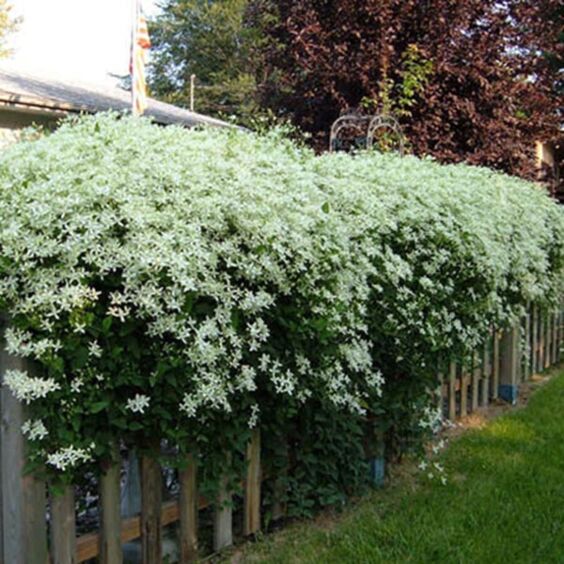
Growing zones
See Zone Map >Status: In stock
Become a Master Gardener with Plants from McKay Nursery
Here at McKay Nursery, we share plants with our customers so they can access a curated collection, including the widely versatile Sweet Autumn clematis vine. Our nursery in Waterloo, Wisconsin, is committed to growing hardy and appealing plants of all shapes and sizes for your landscape design. Order your very own Sweet Autumn clematis vine today and don't forget to purchase a one-year warranty!
For more information, contact us at [email protected] or call us at 920-478-2121.
- Sun, Part Sun/Shade
Mature Plant Size (H x W): 15-20' x 6-10'
Bloom Season: Summer, Fall
- Attracts Bees
- Long Blooming
- Walnut Toxicity Resistant
- Attracts Butterflies
- Fragrant Flowers
- Attracts Pollinators
Planting & Care for Sweet Autumn Clematis Vines (Clematis paniculata)
Preparation
- Clematis like to have their top growth in full sun with their roots in the shade.
- Roots can be shaded with groundcover plants or with other low-growing subjects, with paving slabs or with even a deep mulch of organic matter.
- Clematis grow well in any well-drained, reasonably rich soil containing plenty of humus.
- They are particularly suitable for chalky soils.
- Trim back dead tops early in spring before new growth begins.
- Because this clematis is so vigorous, established plants cut back in spring can grow 15' or more in one season.
- Clematis plants are type 3 (can be late summer or early fall bloomers)
- Keep the plants permanently mulched with organic matter.
- These are “twiners” – climbing plants that twine their new shoots entirely around a support.
- Clematis should not be allowed to suffer from lack of moisture, so water plants well during rainless periods if the soil starts to dry out.
- Plant in February or March.
Planting Groundcovers/Vines
- Groundcovers/Vines: Planting bed should consist of 6-8" of topsoil, well mixed with approximately 2" of peat moss.
Pruning - After Planting
- Groundcovers/Vines: No pruning is needed right away.
Pruning - Through-out the Season
- The only pruning these plants need is thinning when they become congested. This is done after flowering.
- If rejuvenation pruning is needed, cut down the entire plant to within 12 inches of the ground after flowering every three to four years.
Watering - After Planting
- Plants typically take approximately 6 weeks to establish new roots in your soil. During this period, water plants as often as every 2-4 days at the start and at least a minimum of once per week.
- Beyond the six-week establishment period, water once per week unless rain occurs.
- Remember to check soil moisture by sticking your finger into the soil around 3”.
Watering - Through-out the Season
- After the first season, plants should only be watered during extended periods without rain.
- Clematis should not be allowed to suffer from lack of moisture, so water plants well during rainless periods if the soil starts to dry out.
- How do you know if your plants need water? The easiest way to tell is to touch the soil around the roots. If it is moist, there is no need to water. If it is dry, give it a good soaking with the hose end (no nozzle) watering the soil only, not the leaves.
- Stick your finger into the soil around 3” to check soil moisture.
Frequently Asked Questions
How long do Sweet Autumn clematis vines live?
What is the best growing zone for Sweet Autumn clematis vines?
Do Sweet Autumn clematis vines need overwintering?
What are the common issues when growing Sweet Autumn clematis vines?
How much fertilizer do Sweet Autumn clematis plants need?
Planting & Handling Help
Download our Planting and Handling Guide below to plan for a successful arrival and install of your plants. Be sure to water all plants as soon as they arrive and every day until you’re ready to plant. Keep any bare root bundles in a shady, cool spot with the roots covered at all times.


Learn More
Watch our videos on handling bare root plants, how your order is prepared for shipment and more.


Plant Sizing
What is the difference between Containers, Grow Bags, Bare Root, and Balled & Burlap (B&B)?
Shipping Times


Our FedEx and local shipping times depend on two factors, one is by the region and the second is the type of product being shipped. For example, small fruits are only shipped in spring, but majority of our perennials are shipped from spring until fall. Keep in mind the dates below act as a general guide. Due to unpredictable weather, staffing, inventory and industry demands these timelines can change. Therefore, we cannot guarantee any of these times.
Shipping Dates by Region*
Northern Cold Region: April 22nd - November 7th
Northern Region: April 15th - November 7th
Middle Region: April 1st - November 7th
Southern Region: March 15th - November 7th
Local Delivery (small radius from Waterloo, WI): April 22nd - November 7th
Shipping Dates by Season*
Spring Shipping: Region Start Date (above) - May
Fall Shipping: September - November
Due to unpredictable weather, these times may vary. Some varieties are exceptions due to heat and plant health reasons. Enter your shipping zip code at the top of this page and be sure to check the shipping information on each product before you add it to your cart. If the product is too large or restricted in your state, you will not be able to checkout with that item in your cart.




